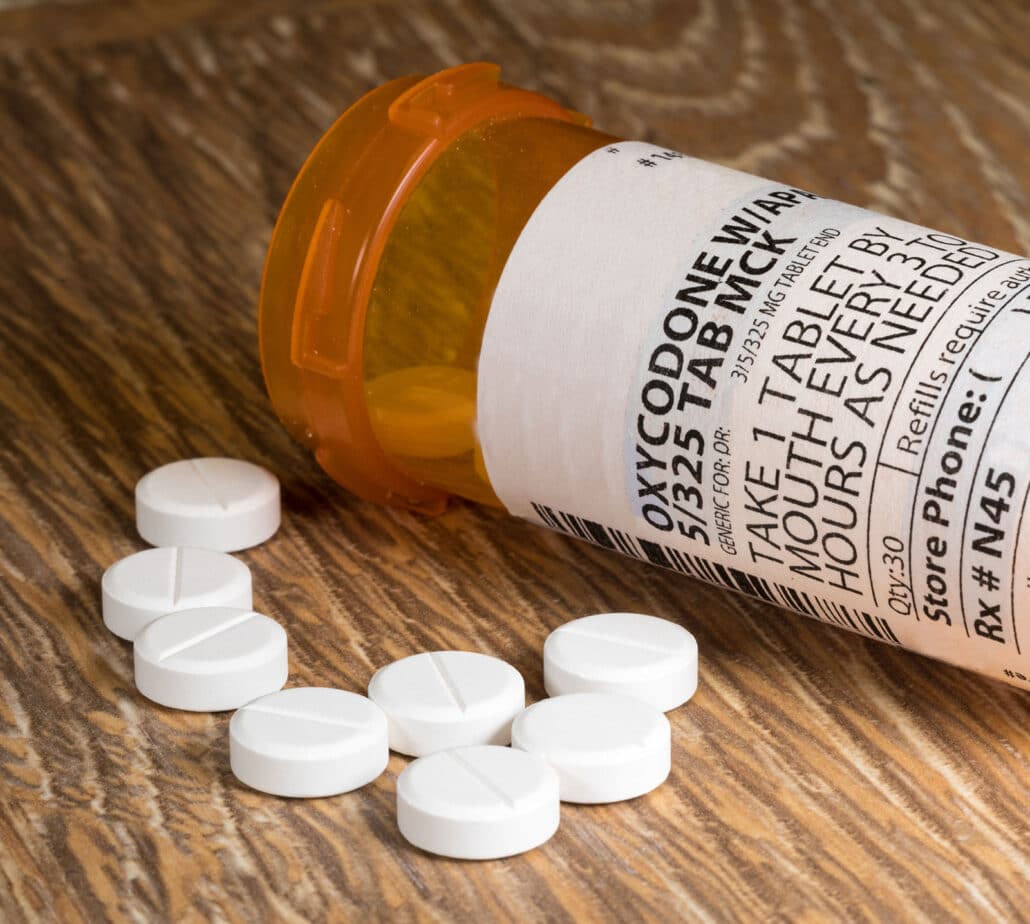Perc 30s are semi-synthetic opioids. That means that they are created in the laboratory from natural opiates, such as oxycodone. Perc 30s are not exactly Percocets. Percocets are prescribed to relieve severe pain, and they contain oxycodone and acetaminophen. Oxycodone is a highly potent opioid that is derived from the same plant that manufacturers use to create heroin.
It is classified under Schedule II of the Controlled Substances Act. As such, it is considered to be highly addictive, so both oxycodone and Percocets are classified under this schedule. One Perc 30 tablet contains 30 milligrams of oxycodone without acetaminophen. Drug manufacturers created these pills in the South Shore and provided customers with counterfeit prescriptions.

In 2011, police officers made mass arrests as people tried to use those fake prescriptions at local pharmacies. Plenty of counterfeit prescription drugs that have the potential to be abused were confiscated like Percocets, Fentanyl, Naloxone, Oxymorphone and Xanax.
At that time, authorities didn’t expect the arrests to make a dent in the drug trade of counterfeit pills. In actuality, the situation became much worse after that. Many people were introduced to oxycodone after they received prescriptions from their doctors. The law enforcement and public health officials have to face a great deal of problem regarding this issue.
Others came to know about the drug after they stole the medication from a friend’s or a relative’s medicine cabinet. The use of opioids increased, but rather than use the more expensive versions of the drug, these people opted to use Perc 30 tablets, and this led to an increase in heroin use.
Table of Contents
How Does Opioid Addiction Occur?
It doesn’t matter who you are. If you take opioids for even a very short period of time, you have a chance of becoming addicted. As a matter of fact, most of the overdose deaths in the United States are related to opioid overdose. When you first start taking opioids, there’s this euphoric high that’s addicting. After some time, you cannot get through the day without taking these drugs.
This occurs because opioids release what is known as the brain’s “feel-good” neurotransmitters or endorphins. Endorphins relieve chronic pain and make you feel extremely good, but the sense of well-being you experience is strong and powerful. These feelings are so pleasurable that it isn’t surprising that you want to experience them again, and it doesn’t take long for you to desire these feelings. This is how the addiction begins.
As you continue to take opioids, the body begins to stop producing as many endorphins as it did in the beginning. Therefore, when you take the number of opioids that you were taking in the beginning, you find that you are not experiencing the same feelings as you did when you first started taking it. This is the point when you have become “tolerant.”
This means that you need to increase your intake of opioids so that you can experience those wonderful feelings again. Because physicians are aware of the highly addictive nature of opioids, they are increasingly unlikely to provide their patients with refills. For this reason, these patients began to turn to Perc 30s and other opioid substitutes.
As you increase your dose of Perc 30s, you are in danger of causing a serious addiction to develop or even causing an overdose. Even so, you must not suddenly stop taking this substance because you will begin to experience withdrawal symptoms, and these symptoms will make it impossible for you to refrain from taking opioids for very long. If you are ready to stop ingesting opioids, the best way to do this is to obtain treatment at a treatment facility.

Oxycodone Side Effects
Oxycodone has several side effects, including the following:
- Mood changes
- Headache
- Flushing
- Drowsiness
- Abdominal pain
- Dry mouth
- Sedation
There are also serious side effects, and they include the following:
- Lightheadedness when moving around
- Extreme drowsiness
- Seizures
- Difficulties swallowing or breathing
- Hoarseness
- Swelling in the lower legs, ankles, feet, hands, eyes, lips, tongue, throat, or face
- Rash
- Itching
- Hives
- Chest pain
- Low libido
- Irregular periods
- Sexual dysfunction
- Dizziness, weakness, decreased appetite, vomiting, and nausea
- Diarrhea or constipation, loss of coordination, severe muscle twitching or stiffness, shivering, rapid heartbeat, confusion, sweating, fever, hallucinations, and agitation
- Changes in heartbeat
- Respiratory depression
Opioid Addiction Treatment
Because it only takes about two weeks for people to experience withdrawal symptoms, your first stop when you arrive at a treatment center must be the detoxification program. When you are in detox, the staff will monitor you 24 hours a day to ensure that you are not experiencing any adverse symptoms. Opioid withdrawal symptoms include the following:
- Yawning
- Sweating
- Runny nose
- Insomnia
- Increased tearing
- Muscle aches
- Anxiety
- Agitation
Withdrawal symptoms in the later stages include the following:
- Vomiting
- Nausea
- Goosebumps
- Dilated pupils
- Diarrhea
- Abdominal cramping
The withdrawal symptoms listed above are extremely uncomfortable for some people, so the staff at your treatment center will administer medications that will relieve them. Also, at this time, your heart rate and blood pressure may increase or decrease to dangerous levels, but because you are being monitored by the medical staff, you will not be in danger of experiencing a medical emergency.
The withdrawal symptoms may cause any physical ailments, and any existing disorder may get worse. But the medications you receive will relieve these uncomfortable physical ailments Then, you will tolerate the withdrawal process comfortably and safely until the toxins are all removed from your body.
The rehabilitation process described above is necessary to ensure that the treatment for your psychological addiction to Perc 30s works. If the drugs are not flushed from your system first, any treatment you receive for your substance use addiction would have less of a chance of leading you toward sobriety for the long term.

The Second Portion of Substance Use Treatment
Treatment for a substance use disorder begins after you leave the detoxification program. You have several options for the continuation of your treatment, including the following:
The Inpatient Program
An inpatient program is an excellent option for you or your loved one if you are entering treatment for the first time. If you have been experiencing substance use disorder for several years, the inpatient program is also a good option for you. In inpatient rehab, you will live at the facility so that you can put all of your efforts into overcoming your addiction.
It is also the right choice for you or your loved one if you do not have a supportive environment to return to after the detoxification process is over. While you are at the facility, you will have a structured environment that offers you support 24 hours a day. Each day, you will join the others in group therapy, and meet with a therapist in individual therapy sessions.
This is where you will receive treatment with the behavioral therapies that is utilized to successfully treat hose with substance use disorders. These programs may last for 30 days, but you may also decide to enter into a program that lasts longer. A professional will help you determine the type of treatment that is best for you or your loved one when you first arrive at the treatment center.
The Outpatient Program
Treatment facilities may also have an outpatient program, and it is most appropriate for you or your loved one if you need a place to go after your inpatient program ends. You will be able to live at home if this is a safe place for you, and you will visit the facility for 10 to 12 hours every week.
You will continue to receive the beneficial group therapy and individual therapy you had in inpatient treatment. Most importantly, you will learn how to live outside of a facility without resorting to substance use.
An outpatient program is an option for you or your loved one if your addiction is not very severe. It is also an excellent program for you if you are searching for a way to continue your treatment. Some programs last as long as one year, but you can also choose a three-month program.
Whether you choose inpatient or outpatient treatment, the rehabilitation process will have long-lasting, positive consequences for you or your loved one. The medical community now knows that addiction is a chronic illness and that it needs to be treated as such.
As you obtain treatment from professionals over the long term, support groups and counseling will prevent you or your loved one from relapsing and falling into drug use again. Contact a drug treatment center and get help for yourself or your loved one today.
Contact Long Island Interventions Today
If you’re concerned about a loved one with substance abuse disorder, whether be it Perc 30, oxy, or other prescription medications, do not wait for a drug overdose to happen, because it is possible and unfortunately prevalent.
There’s a team of highly trained healthcare professionals to help your loved one overcome substance abuse. Here at Long Island Interventions, we aim for your loved one to have second chance at living a better and happier life. It all starts with one phone call, contact us today!
Published on: 2022-01-26
Updated on: 2024-07-11

